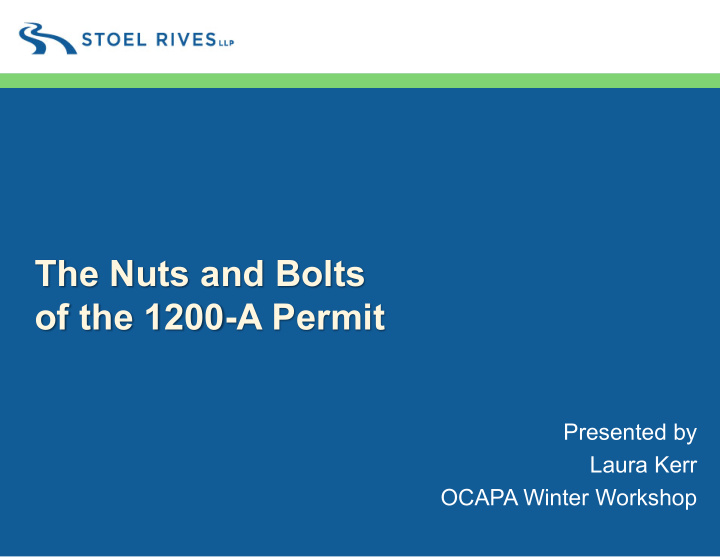



The Nuts and Bolts of the 1200-A Permit Presented by Laura Kerr OCAPA Winter Workshop
What We Will Cover • Is your facility covered under the 1200-A • How to obtain coverage under the NPDES 1200-A General Permit (“1200-A”) • A general overview of the permit • Focus on specific permit requirements • Narrative technology-based effluent limits • Authorized vs. non-authorized stormwater discharges • The Stormwater Pollution Control Plan • Benchmarks, reference concentrations and effluent limits
W HO I S C OVERED UNDER THE 1200-A • If your facility is a covered facility – Has a primary Standard Industrial Classification (SIC) code 14, Mining and Quarrying of Nonmetallic Minerals; or – Asphalt mix batch plants and concrete batch plants, including mobile operations of this type, are required to obtain coverage under the permit AND • May discharge stormwater or mine dewatering water from a point source to surface waters or conveyance systems that discharge to surface waters. YOU NEED A 1200-A PERMIT 3
D ISCHARGES AUTHORIZED B Y THE 1200-A • Stormwater • Mine dewatering water – Water that is impounded or that collects in the mine and is pumped, drained, or otherwise removed from the mine through the efforts of the mine operator. – Includes wet pit overflows caused solely by direct rainfall and ground water seepage. – If co-mingled with process water, not authorized! • Non-stormwater discharges 4
O BTAINING C OVERAGE UNDER THE 1200-A • The general permit itself specifies the requirements for obtaining coverage • Currently, the 1200-A requires: – An application for coverage – Public notice and a 30-day written comment period – Written DEQ approval of coverage • Important Caveat: On Dec. 3, 2017, the 1200-A expired and is currently administratively extended – DEQ prohibits new applicants from obtaining coverage under administratively extended permits 5
A N O VERVIEW OF THE 1200-A P ERMIT R EQUIREMENTS • Schedule A: Technology Based Limitations, Water Quality Based Limitations, Stormwater Pollution Control Plan, Benchmarks and Corrective Action • Schedule B: Monitoring and Reporting Requirements • Schedule C: Compliance Schedules • Schedule D: Special Conditions • Schedule E: Sector Specific Requirements • Schedule F: General Conditions 6
N ARRATIVE T ECHNOLOGY -B ASED E FFLUENT L IMITS • Erosion and sediment control • Debris Control • Containment, Covering • Routine housekeeping Activities and Stormwater • Spill prevention and response Diversion/Minimize Exposure procedures • Oil and Grease (eliminate or • Preventative Maintenance minimize) • Employee Education • Waste Chemicals and Material • Non-stormwater discharges Disposal (eliminating unauthorized discharges) Control measures used by permit registrant to meet the narrative technology-based effluent limits must be “ technologically available and economically practicable and achievable in light of best industry practice ” 7
A UTHORIZED VS . U NAUTHORIZED N ON - S TORMWATER D ISCHARGES • Authorized non-stormwater • Unauthorized non-stormwater discharges include: discharges include: – Uncontaminated condensate from – All other non-stormwater air conditioners, coolers etc. discharges including process – Irrigation drainage wastewater – Certain landscape watering • Note: mine dewatering – Certain pavement wash waters discharges composed – Vehicle washing that does not use entirely of stormwater or detergents or hot water uncontaminated groundwater – Routine external building are not process wastewater washdown that does not use detergents or hot water. – Uncontaminated groundwater or spring water. – Foundation or footing drains where flows are not contaminated with process materials. 8
• A DDITIONAL L IMITS OF N OTE • Water Quality Based Effluent Limits (“The permit registrant must not cause or contribute to a violation of instream water quality standards as established in OAR 340-041.”) • Limits for discharges to impaired waterbodies – Impaired waterbodies in Oregon – TMDLs – Application to permit registrant • Limit on the discharge of “significant amounts of sediment to surface waters” (permit registrant must prevent) 9
S TORMWATER P OLLUTION C ONTROL P LANS (SWPCP) • DOGAMI Operating Permit and Reclamation Plan may be substituted for a SWPCP – If it contains all required SWPCP elements and information • The SWPCP must include information such as: – Detailed Site Description – Procedures and schedules to meet technology based effluent limits – Employee training procedures • The SWPCP is a living, breathing document – Must be retained on site – Must revised to reflect conditions on site (certain revisions must be submitted to DEQ or agent) 10
S TORMWATER P OLLUTION C ONTROL P LANS T IPS • SWPCP – should address and meet every significant applicable term of 1200-A permit – should not include non-permit-required activities or even more ambitious schedules (use separate documentation): • “Failure to implement any of the control measures or practices described in the SWPCP is a violation of the permit.” 11
B ENCHMARKS , R EFERENCE C ONCENTRATIONS AND E FFLUENT L IMITS • Benchmarks, reference concentrations and effluent limits, oh my! What is the difference? • Benchmarks • Reference concentrations 12
B ENCHMARKS , R EFERENCE C ONCENTRATIONS AND E FFLUENT L IMITS • Effluent Limits 13
E XCEEDANCES AND C ORRECTIVE A CTION • What happens when you have an exceedance? – Legal significance of exceedances of a benchmark vs. reference concentration vs. effluent limit – These are permit violations if you have a benchmark or reference concentration exceedance: • Failure to investigate and determine if corrective action is required or if SWPCP revisions are required • Failure to prepare correction action report • Failure to implement the corrective action • DOCUMENT EACH STEP! • Corrective Action Requirements – Tier I vs. Tier II 14
A DDITIONAL P ERMIT R EQUIREMENTS • To be discussed in detail this afternoon: –Monitoring –Inspections –Reporting and recordkeeping 15
Write It! Communicate It! (SWPCP and revisions) (Employee Education) Stormwater Permit Continuous Improvement Cycle Implement Do It! Action Plans! Inspect and Document! (DMRs, monitoring reports, monthly inspection reports, Corrective Action Plans) 16
What To Expect in the Next Permit
Q UESTIONS /C OMMENTS ? Laura Kerr (503) 294-9176 laura.kerr@stoel.com 18
Recommend
More recommend